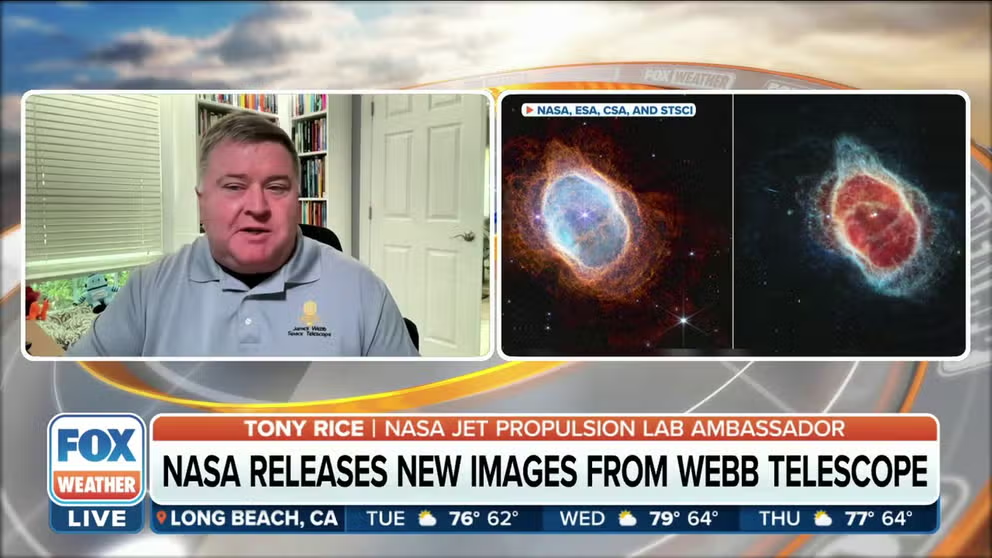James Webb Space Telescope images wow by showing star nursery, galaxies in a cosmic dance
NASA, ESA and CSA reveal the first color images from the James Webb Space Telescope
NASA reveals first full-color images from James Webb Space Telescope
Tony Rice, Ambassador for the NASA Jet Propulsion Laboratory, gives his reaction to seeing the first full-color images from the James Webb Space Telescope.
Images captured by the James Webb Space Telescope released Tuesday by NASA revealed what an international collaboration of science and engineering could achieve: a masterpiece of science.
The first color images from JWST are a milestone only possible through the largest international space science partnership – a collaboration between NASA, the European Space Agency, the Canadian Space Agency and the Space Telescope Science Institute – two decades in the making.
On Tuesday, NASA held a release event to share the first handful of color images captured by the observatory located about 1 million miles from Earth. The event felt more like a pep rally than a stuffy science announcement. Cheerleaders holding pom-poms and golden mirror replicas like the 18 hexagon mirrors on Webb lined the hall at Goddard Space Center in Maryland for the announcement.
With infrared light, JWST can see through dust in the universe, revealing the very first galaxies, almost back to the Big Bang. The "eyes" of Webb are a thousand times greater than the Hubble Space Telescope launched in 1990.
Take a closer look at the images released Tuesday.
Baby stars of the ‘Cosmic Cliffs’
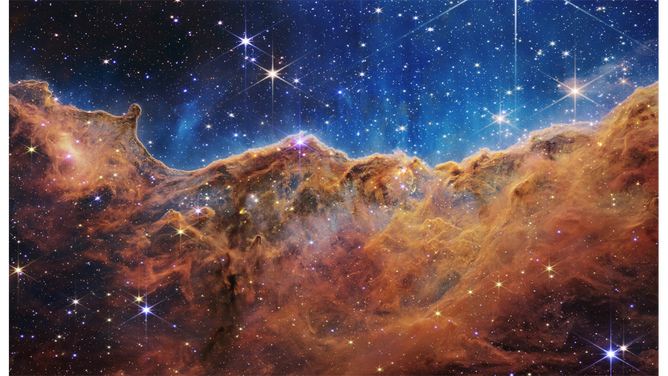
"Cosmic Cliffs" in the Carina Nebula (NIRCam Image) (IMAGE: NASA/ESA/CSA/STScI)
One of the most jaw-dropping images NASA revealed on Tuesday was the star-forming region known as NGC 3324 in the Carina Nebula. This area, nicknamed the "Cosmic Cliffs," is where stars are born and were previously hidden from other space telescopes.
Using the James Webb Space Telescope's Near-Infrared Camera (NIRCam), this star nursery was revealed in crisp resolution, looking like mountains by moonlight.
A quintet of galaxies
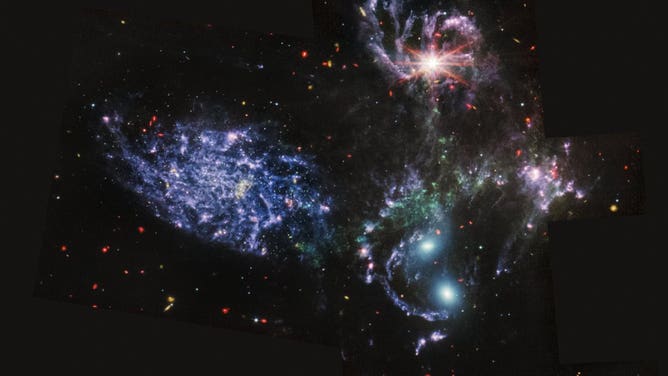
An enormous mosaic of Stephan’s Quintet is the largest image to date from NASA’s James Webb Space Telescope, covering about one-fifth of the Moon’s diameter. It contains over 150 million pixels and is constructed from almost 1,000 separate image files. The visual grouping of five galaxies was captured by Webb’s Near-Infrared Camera (NIRCam) and Mid-Infrared Instrument (MIRI). IMAGE: NASA, ESA, CSA, STScI
ESA revealed the largest image taken by Webb yet of five galaxies that make up a system known as Stephan's Quintet. Even though it's called a quintet, only four of the galaxies are close enough together to be in a cosmic dance, according to the Space Telescope Science Institute. The galaxies are as close as 40 million light-years from Earth and as far as 290 million light-years away.

An enormous mosaic of Stephan’s Quintet is the largest image to date from NASA’s James Webb Space Telescope, covering about one-fifth of the Moon’s diameter. It contains over 150 million pixels and is constructed from almost 1,000 separate image files. The visual grouping of five galaxies was captured by Webb’s Near-Infrared Camera (NIRCam) and Mid-Infrared Instrument (MIRI).IMAGE: NASA, ESA, CSA, STScI
The composite image was created using JWST's NIRCam and Mid-Infrared Instrument (MIRI) instruments.
'NAILED IT': JAMES WEBB SPACE TELESCOPE'S FIRST IMAGE IS SOMETHING TO CELEBRATE
The image above contains more than 1,000 separate image files and 150 million pixels.
If the grouping looks familiar, you might recall a much older image of the quintet was used in the angelic conversation scene in the film "It's A Wonderful Life."
Galaxy cluster SMACS 0723

The sharpest infrared view of the universe to date: Webb's First Deep Field. Previewed on July 11, 2022, it shows galaxies once invisible to us.
(NASA)
On Monday, President Joe Biden helped reveal the first infrared color image taken by the observatory. The Deep Field image shows thousands of galaxies in sharp detail but is only a rice-grain-sized portion of our night sky.
Hubble imaged the same area of the universe, and it took two weeks. Webb's exposure was just 12 hours and had much more clarity.
"It's teeming with galaxies. And that's something that has been true for every image we've gotten with Webb," JWST operations project scientist Jane Rigby said.
Because the speed of light travels only so fast, the image shows the galaxies as they looked billions of years ago.
"These cluster galaxies, the white ones, we're seeing as they looked about the time the sun and the Earth formed," Rigby said.
‘Dying star’
Approximately 2,500 light-years away, NGC 3131 is known as the Southern Ring Nebula.
Using the observatory's NIRCam and MIRI, Webb observed a dying star in the Southern Ring Nebula, two stars closely orbiting each other in layers of gas and dust.
Webb scientists are excited by this clear view of Stephan’s Quintet’s topmost galaxy (NGC 7319) because it contains – a supermassive black hole. Webb's "MIRI sees through the dust surrounding this black hole to unveil the strikingly bright active galactic nucleus," according to the ESA.
Hot exoplanet WASP-96b
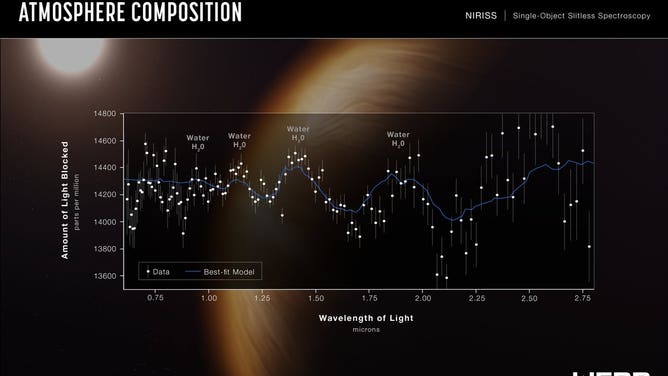
Canada’s instrument NIRISS on Webb reveals the distinct signature of water in the atmosphere of a hot, puffy gas giant exoplanet orbiting a distant Sun-like star. (Image: NASA, ESA, CSA, STScI, and the Webb ERO Production Team)
The next object Webb studied was the exoplanet called WASP-96b, a scorching gas giant world orbiting a sun-like star more than 1,000 light-years away. The Canadian Space Agency-built Near-Infrared Imager, and Slitless Spectrograph was used to capture water signatures, including the evidence of clouds and haze around the world.
WHO WAS JAMES WEBB? THE NAMESAKE BEHIND THE SPACE TELESCOPE
A brief history of JWST
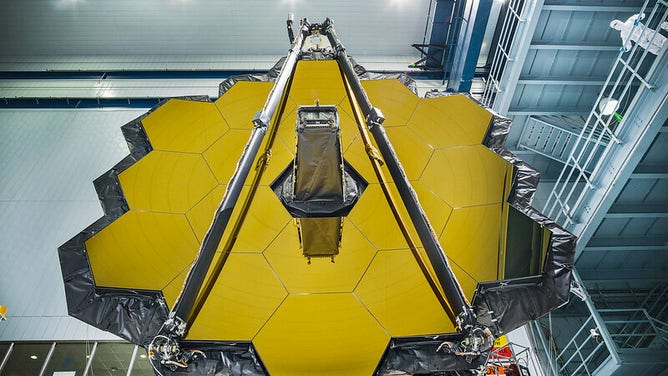
An archival October 2016 images of James Webb’s fully assembled primary mirror. Image credit: NASA/Chris Gunn
(NASA)
To get to the point where Webb was beaming back images from 1 million miles away, NASA and its partners had to build the largest telescope ever created with a 6.5-meter primary mirror and sun shield the size of a tennis court. Then, the telescope had to be folded safely, shipped across the world, and prepared for launch from French Guiana. After years of delays and a decade of testing and development, the JWST launched on Christmas morning, beginning its 1 million-mile journey.
James Webb Space Telescope launches on Christmas Day
Ariane 5 rocket launches from French Guiana sending James Webb on its journey 1 million miles from Earth.
Along the way to its home in deep space, the telescope unfolded its mirrors, opened its sunshield and teams began commissioning its instruments for science, a 300-step process completed earlier this week.
HOW TO MOVE A $10 BILLION SPACE TELESCOPE 5,800 MILES, AVOID PIRATES AND SEE BACK INTO THE COSMOS
Webb senior project scientist John Mather first began working on JWST before it had a name in 1995.
The Nobel Prize laureate was relieved when he first saw the images come back from the observatory.
"I am thrilled and relieved because, you know, when you start something this big, you know, there's always a possibility it might not work. It did work," Mather said. "We are so proud."
Webb is now ready to begin science observations that will likely create more questions about our universe but also give a new understanding of how we got here, including if we are alone.
